Crosslinking Dependence of Direct Current Breakdown Performance for XLPE-PS Composites at Different Temperatures
Abstract
1. Introduction
2. Materials and Methods
2.1. Sample Preparation
2.2. DC Dielectric Performance Measurements
2.3. Structural Characterization
2.4. Dynamic Mechanical Analysis
3. Results
3.1. DC Breakdown Properties
3.2. Space Charge Behaviors
3.3. Cryogenically Fractured Morphology
3.4. Degree of Crosslinking and Crystallinity
3.5. Thermo-Mechanical Performance
4. Discussion
5. Conclusions
Supplementary Materials
Author Contributions
Funding
Institutional Review Board Statement
Informed Consent Statement
Data Availability Statement
Acknowledgments
Conflicts of Interest
References
- Orton, H. Power cable technology review. High Volt. Eng. 2015, 41, 1057–1067. [Google Scholar]
- Chen, G.; Hao, M.; Xu, Z.; Vaughan, A.; Cao, J.; Wang, H. Review of high voltage direct current cables. CSEE J. Power Energy Syst. 2015, 1, 9–21. [Google Scholar] [CrossRef]
- Murakami, Y.; Nemoto, M.; Okuzumi, S.; Masuda, S.; Nagao, M.; Hozumi, N.; Sekiguchi, Y.; Murata, Y. DC conduction and electrical breakdown of MgO/LDPE nanocomposite. IEEE Trans. Dielectr. Electr. Insul. 2008, 15, 33–39. [Google Scholar] [CrossRef]
- Wang, S.; Zha, J.; Li, W.; Zhang, D.; Dang, Z. Sandwiched structure effect on space charge characteristics of alumina/polyethylene nanocomposites. IEEE Trans. Dielectr. Electr. Insul. 2017, 24, 1365–1371. [Google Scholar] [CrossRef]
- Roy, M.; Nelson, J.K.; MacCrone, R.K.; Schadler, L.S. Candidate mechanisms controlling the electrical characteristics of silica/XLPE nanodielectrics. J. Mater. Sci. 2007, 42, 3789–3799. [Google Scholar] [CrossRef]
- Wang, S.; Chen, P.; Yu, S.; Zhang, P.; Li, J.; Li, S. Nanoparticle dispersion and distribution in XLPE and the Related DC insulation performance. IEEE Trans. Dielectr. Electr. Insul. 2018, 25, 2349–2357. [Google Scholar] [CrossRef]
- Ju, S.; Chen, M.; Zhang, H.; Zhang, Z. Dielectric properties of nanosilica/low-density polyethylene composites: The surface chemistry of nanoparticles and deep traps induced by nanoparticles. Express Polym. Lett. 2014, 8, 682–691. [Google Scholar] [CrossRef]
- Wang, S.; Yu, S.; Xiang, J.; Li, J.; Li, S. DC breakdown strength of crosslinked polyethylene based nanocomposites at different temperatures. IEEE Trans. Dielectr. Electr. Insul. 2020, 27, 482–488. [Google Scholar] [CrossRef]
- Luo, Y.; Wu, G.; Peng, J.; Zhang, Y.; Xu, H.; Wang, P. Research progress on interface properties of polymer nanodielectrics. High Volt. Eng. 2012, 38, 2455–2464. [Google Scholar]
- Cao, L.; Zhong, L.; Li, Y.; Zhang, K.; Gao, J.; Chen, G. Enhanced high-temperature DC dielectric performance of crosslinked polyethylene with a polystyrene pinning structure. Materials 2019, 12, 1234. [Google Scholar] [CrossRef]
- Yan, Z.; Yang, K.; Zhang, Y.; Wang, S.; Li, J. Crosslinking dependence of trap distribution and breakdown performance of crosslinked polyethylene. J. Mater. Sci. Mater. Electron. 2019, 30, 20605–20613. [Google Scholar] [CrossRef]
- Fu, M.; Chen, G.; Dissado, L.A.; Fothergill, J.C. Influence of thermal treatment and residues on space charge accumulation in XLPE for DC power cable application. IEEE Trans. Dielectr. Electr. Insul. 2007, 14, 53–64. [Google Scholar] [CrossRef]
- Ghorbani, H.; Abbasi, A.; Jeroense, M.; Gustafsson, A.; Saltzer, M. Electrical characterization of extruded DC cable insulation—The challenge of scaling. IEEE Trans. Dielectr. Electr. Insul. 2017, 24, 1465–1475. [Google Scholar] [CrossRef]
- Song, S.; Zhao, H.; Yao, Z.; Yan, Z.; Yang, J.; Wang, X.; Zhao, X. Enhanced electrical properties of polyethylene-graft-polystyrene/LDPE composites. Polymers 2020, 12, 124. [Google Scholar] [CrossRef] [PubMed]
- Zhou, Y.; Hu, J.; Dang, B.; He, J. Mechanism of highly improved electrical properties in polypropylene by chemical modification of grafting maleic anhydride. J. Phys. D Appl. Phys. 2016, 49, 415301. [Google Scholar] [CrossRef]
- Zhang, W.; Xu, M.; Chen, G.; Hou, S.; Fu, M.; Li, W. Structure and properties of isotactic polypropylene and ethylene-propylene copolymer. High Volt. Eng. 2017, 43, 3634–3644. [Google Scholar]
- Mi, R.; Xing, Z.; Hao, J.; Hu, X.; Min, D.; Li, S.; Wu, Q. Effect of morphology and traps on DC conductivity and breakdown of polyethylene nanocomposites. IEEE Trans. Dielectr. Electr. Insul. 2020, 27, 489–497. [Google Scholar] [CrossRef]
- Montanari, G.C.; Laurent, C.; Teyssedre, G.; Campus, A.; Nilsson, U.H. From LDPE to XLPE: Investigating the change of electrical properties. Part I: Space charge, conduction and lifetime. IEEE Trans. Dielectr. Electr. Insul. 2005, 12, 438–446. [Google Scholar] [CrossRef]
- Zhao, J.; Chen, G.; Zhong, L. Space charge in polyethylene under combined AC and DC voltages. IEEE Trans. Dielectr. Electr. Insul. 2014, 21, 1757–1763. [Google Scholar] [CrossRef]
- Wallgren, E.; Hult, A.; Gedde, U.W. Crosslinking of binary blends of branched polyethylene and poly(1,2-butadiene): 1. Molecular structure and kinetics. Polymer 1993, 34, 2585–2591. [Google Scholar] [CrossRef]
- Li, L.; Zhang, K.; Zhong, L.; Gao, J.; Xu, M.; Chen, G.; Fu, M. Treeing phenomenon of thermoplastic polyethylene blends for recyclable cable insulation materials. AIP Adv. 2017, 7, 025116. [Google Scholar] [CrossRef]
- Hussin, N.; Chen, G. Analysis of space charge formation in LDPE in the presence of crosslinking byproducts. IEEE Trans. Dielectr. Electr. Insul. 2012, 19, 126–133. [Google Scholar] [CrossRef]
- Doedens, E.; Jarvid, E.M.; Frohne, C.; Gubanski, S.M. Enhanced charge injection in rough HVDC extruded cable interfaces. IEEE Trans. Dielectr. Electr. Insul. 2019, 26, 1911–1918. [Google Scholar] [CrossRef]
- Chen, X.; Paramane, A.; Liu, H.; Tie, J.; Tanaka, Y. Enhancement of service life and electrical insulation properties of polymeric cables with the optimum content of aromatic voltage stabilizer. Polym. Eng. Sci. 2020, 60, 717–731. [Google Scholar] [CrossRef]
- Xu, Y.; Luo, P.; Xu, M.; Sun, T. Investigation on insulation material morphological structure of 110 and 220 kV XLPE retired cables for reusing. IEEE Trans. Dielectr. Electr. Insul. 2014, 21, 1687–1696. [Google Scholar] [CrossRef]
- Niwa, T.; Hatada, M.; Miyata, H.; Takahashi, T. Studies on the improvement of breakdown strength of polyolefins. IEEE Trans. Dielectr. Electr. Insul. 1993, 28, 30–34. [Google Scholar] [CrossRef]
- Wang, X.; He, H.Q.; Tu, D.M.; Lei, C.; Du, Q.G. Dielectric properties and crystalline morphology of low density polyethylene blended with metallocene catalyzed polyethylene. IEEE Trans. Dielectr. Electr. Insul. 2008, 15, 319–326. [Google Scholar] [CrossRef]
- Liu, X.; Yu, Q.; Liu, M.; Li, Y.; Zhong, L.; Fu, M.; Hou, S. DC electrical breakdown dependence on the radial position of specimens with HVDC XLPE cable insulation. IEEE Trans. Dielectr. Electr. Insul. 2017, 24, 1476–1484. [Google Scholar] [CrossRef]
- Guo, Q.; Yang, L.; Li, X.; Li, W.; Yao, Z. The influence of nano-PS particle on structure evolution and electrical properties of PP/PS. J. Polym. Sci. Part B Polym. Phys. 2018, 56, 706–717. [Google Scholar] [CrossRef]
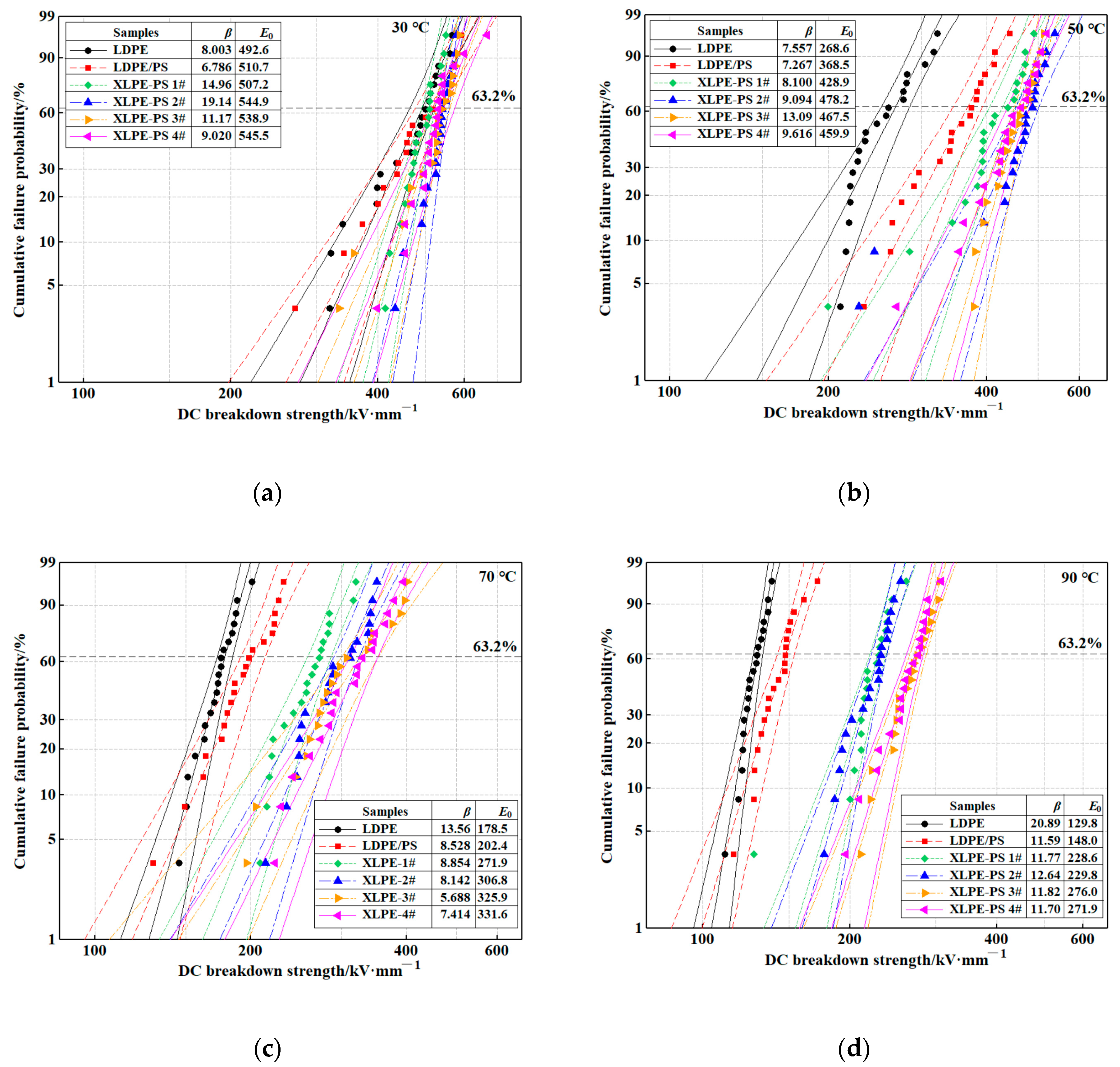
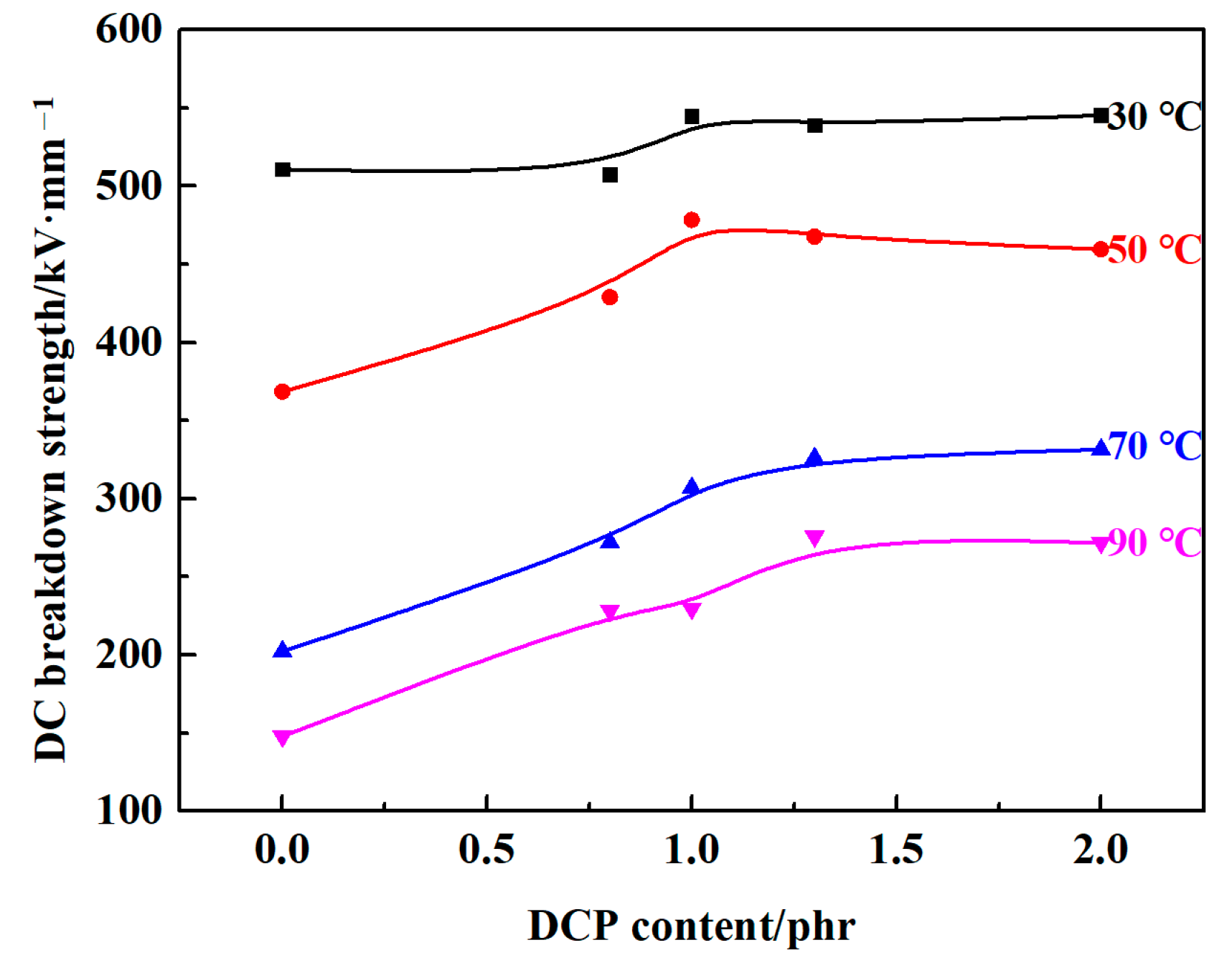
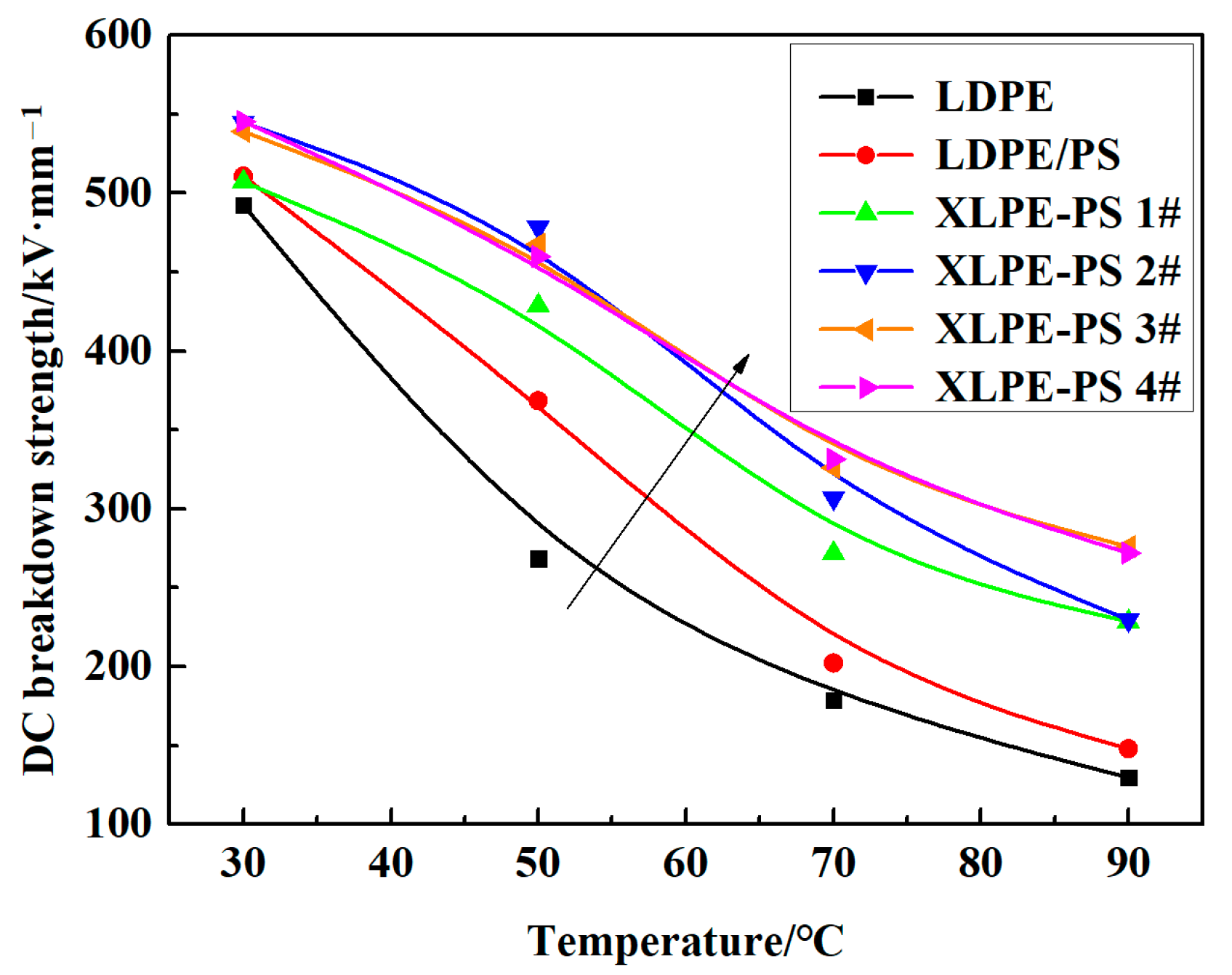

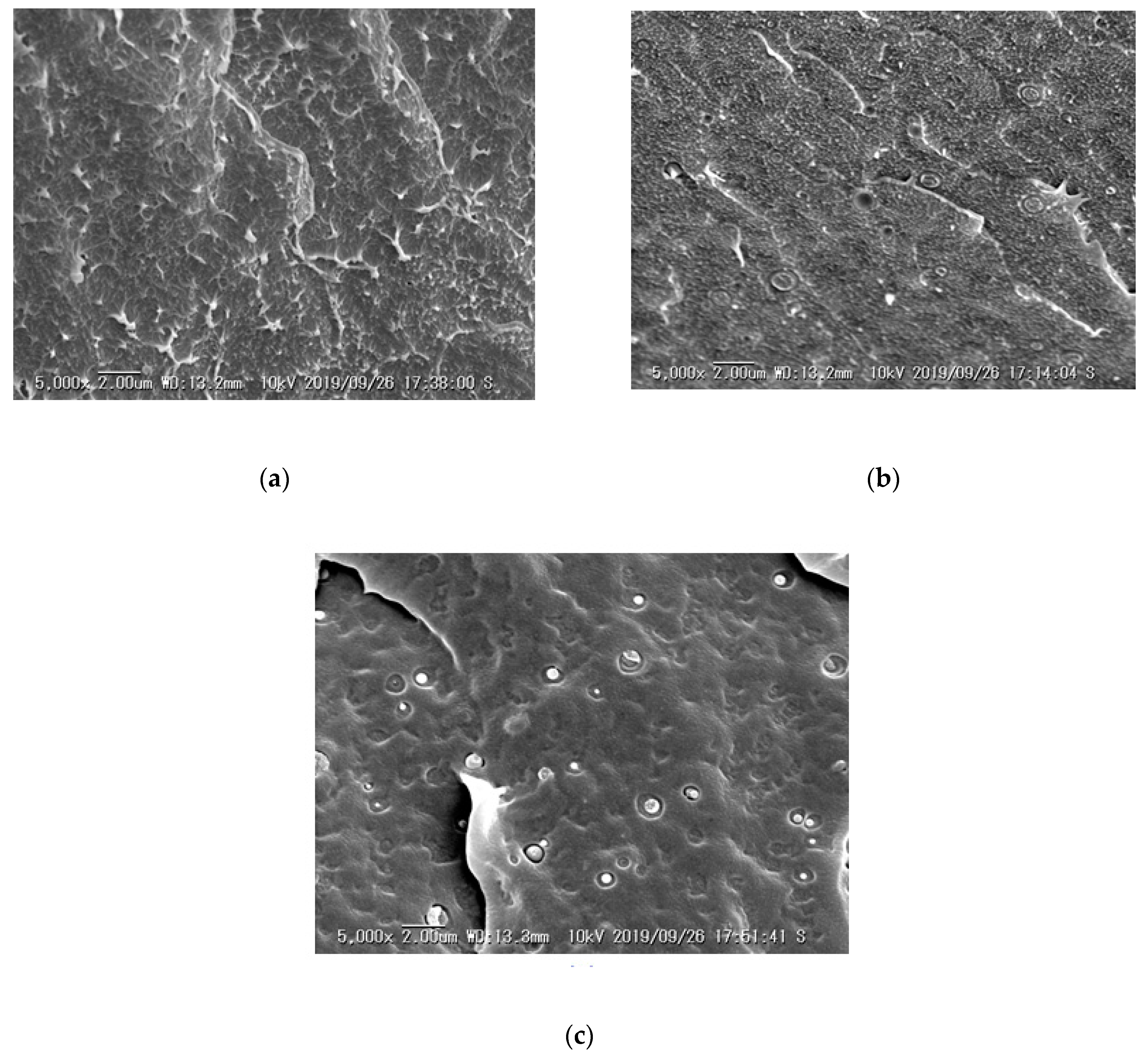
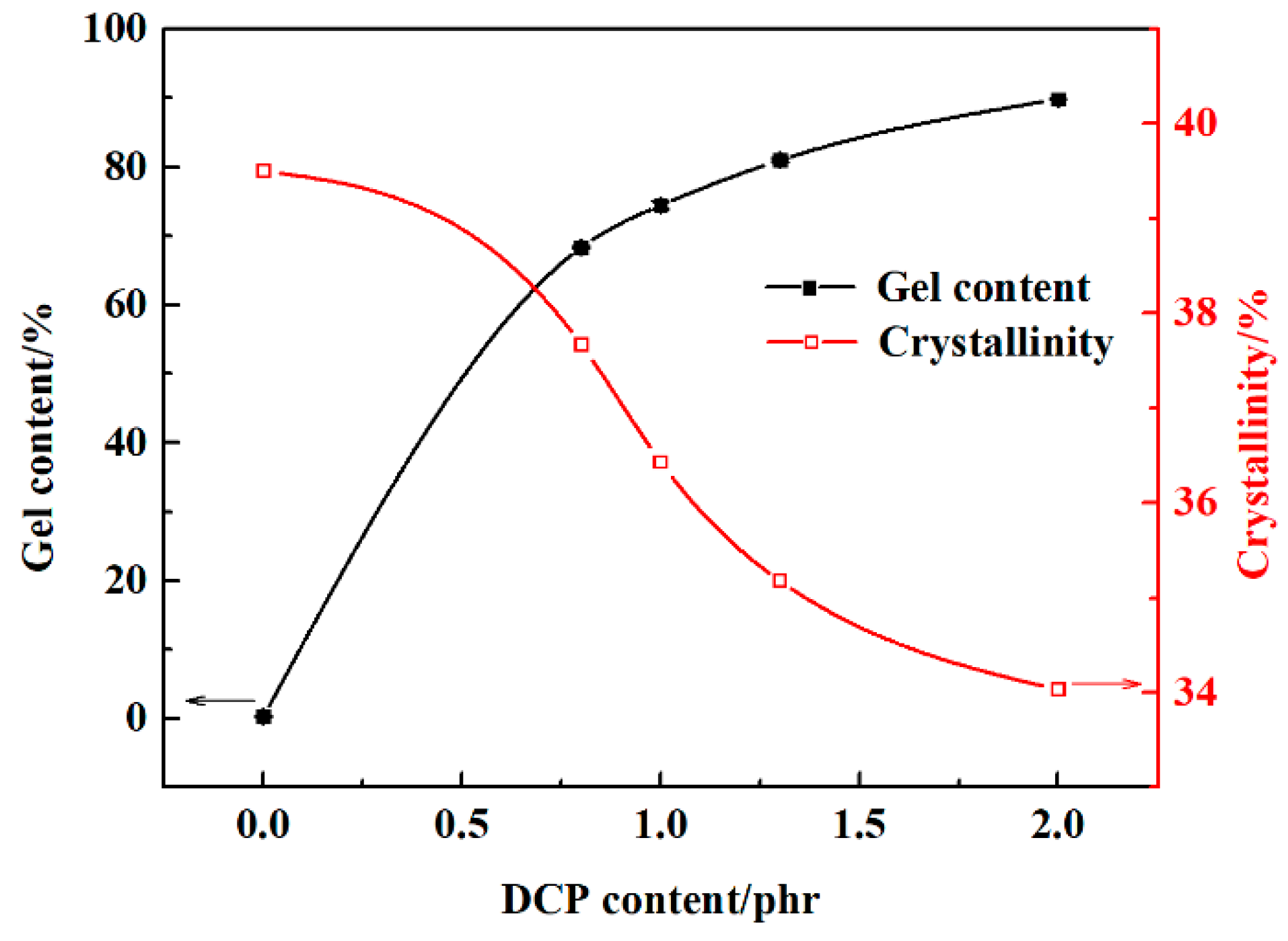
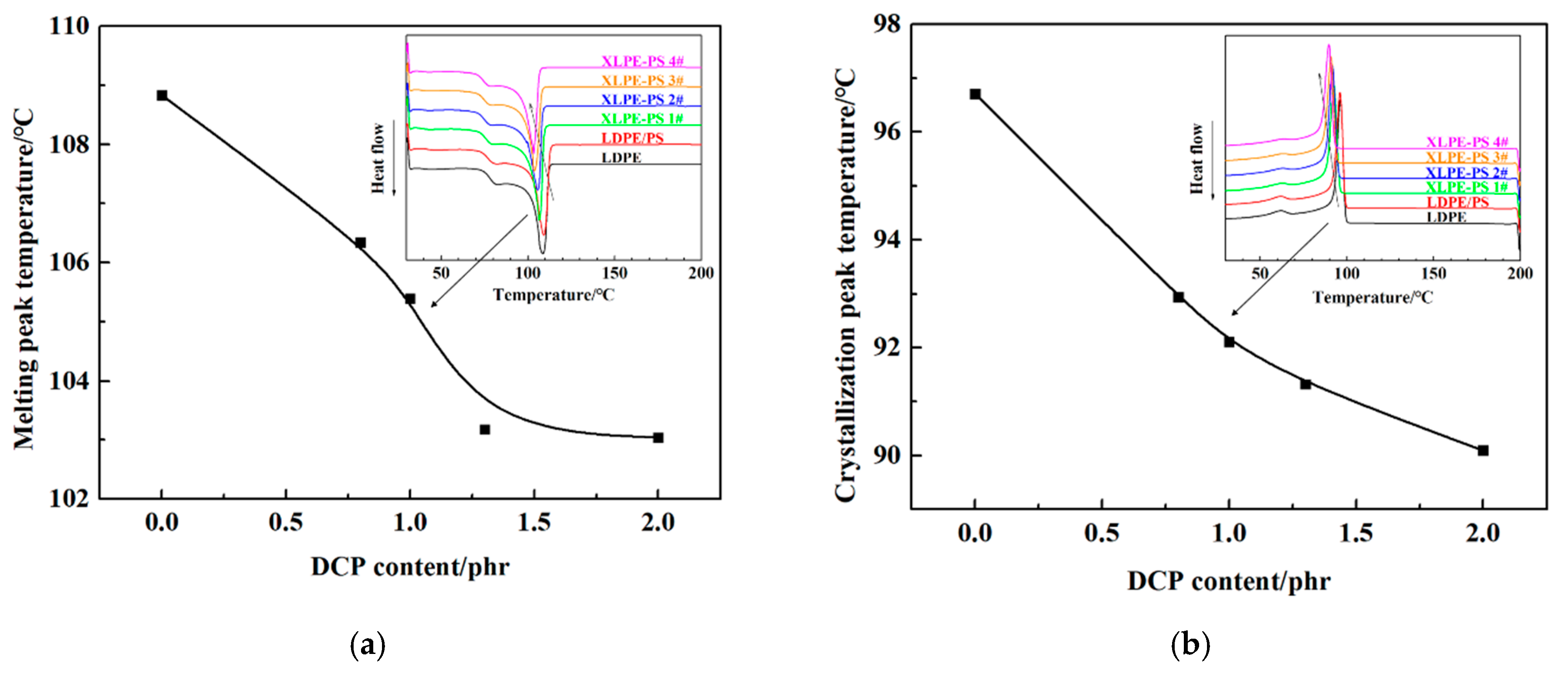

| Designation | LDPE Content/phr | PS Content/phr | DCP Content/phr |
|---|---|---|---|
| LDPE | 100 | 0 | 0 |
| LDPE/PS | 100 | 1 | 0 |
| XLPE-PS 1# | 100 | 1 | 0.8 |
| XLPE-PS 2# | 100 | 1 | 1 |
| XLPE-PS 3# | 100 | 1 | 1.3 |
| XLPE-PS 4# | 100 | 1 | 2 |
Publisher’s Note: MDPI stays neutral with regard to jurisdictional claims in published maps and institutional affiliations. |
© 2021 by the authors. Licensee MDPI, Basel, Switzerland. This article is an open access article distributed under the terms and conditions of the Creative Commons Attribution (CC BY) license (http://creativecommons.org/licenses/by/4.0/).
Share and Cite
Cao, L.; Zhong, L.; Li, Y.; Gao, J.; Chen, G. Crosslinking Dependence of Direct Current Breakdown Performance for XLPE-PS Composites at Different Temperatures. Polymers 2021, 13, 219. https://doi.org/10.3390/polym13020219
Cao L, Zhong L, Li Y, Gao J, Chen G. Crosslinking Dependence of Direct Current Breakdown Performance for XLPE-PS Composites at Different Temperatures. Polymers. 2021; 13(2):219. https://doi.org/10.3390/polym13020219
Chicago/Turabian StyleCao, Liang, Lisheng Zhong, Yinge Li, Jinghui Gao, and George Chen. 2021. "Crosslinking Dependence of Direct Current Breakdown Performance for XLPE-PS Composites at Different Temperatures" Polymers 13, no. 2: 219. https://doi.org/10.3390/polym13020219
APA StyleCao, L., Zhong, L., Li, Y., Gao, J., & Chen, G. (2021). Crosslinking Dependence of Direct Current Breakdown Performance for XLPE-PS Composites at Different Temperatures. Polymers, 13(2), 219. https://doi.org/10.3390/polym13020219






